The call came in as “cow down cliff, caught in trees, 3 years old, feisty”.
On site, we found a rust-colored cow about 50 feet down a steep incline. She stood in some brush and watched us, tossing her head nervously as more people arrived on site and looked over the edge.
Arriving shortly after us was Dr. Pete Sathre of Plateau Veterinary in Enumclaw, WA. We’ve been on a very similar rescue with Dr. Pete before so he knew what to expect and how to work with the team.
The team got busy setting up the tripod, which would act as a redirect so we could get the cow over the lip of the edge with as little trouble as possible. Guy lines were attached to the top of the tripod, and the haul rope routed through the apex of the tripod and back for the haul team.
Once the tripod was nearly set up, Dr. Pete headed down the hill with a sedative on the end of a pole. As he got closer, Roberta the cow tried to turn toward him. His presence was a threat and she felt vulnerable. She’d had a calf with her until just recently and the calf was not in the area but somewhere separated.
Dr. Pete managed to give Roberta an injection. She tried to bolt through the brush. We were concerned she may go farther down into the ravine, or traverse the slope away from the fall line of where we’d set up the tripod, meaning we’d either have to move the tripod and rigging or get Roberta back in line with where the rope would naturally fall. Otherwise we’d be fighting gravity the whole way. But she didn’t go far; she just wanted some space from Dr. Pete.
In the movies, you see an animal receive a sedative from a dart or rifle and the fall immediately. It reality it takes a while for the sedative to start working. In a situation like Roberta’s, where she has some extra adrenaline present, it may take more of the drug as well. Additionally, Roberta was a Dexter, a breed of cow that is pretty small—maybe 600 lbs. in the case of our subject.
After a few minutes, she laid down and went to sleep.
Fortunately for us, it was in a better position than when we’d first found her. Unfortunately for both us and her, she was now napping in a garbage pile. The property she’d been found in was vacant and the hillside had been used as a garbage dump at some point in time. There was an abundance of sharp metals, broken glass, boards with nails in them, and some Mardi Gras beads.
Once she was asleep, we made our way down through the nettles, brush, and trees with the glide and some rigging equipment.
We put the glide in place, against Roberta’s hooves with the glide’s nose facing uphill. We put some vehicle recovery straps around her to pull her over, though we ended up rolling her onto the glide instead. We then attached the straps to a haul rope and had the team pull her up a bit on the glide so we could bend the back of the glide in and secure her with straps. Once that was done, we moved the haul rope to the attachment point under the nose of the glide along with a pulley to give us some mechanical advantage there.
After finishing up tucking her in and securing her hooves, we checked everything. It looked ready to go, and small snores came from Roberta. Dr. Pete felt comfortable with her situation and we called the haul. We had some extra plastic sheets in place to help mitigate the friction as Roberta’s glide when up the steep slope and over some more garbage and logs that we’d been unable to move. The haul went at a slow and safe pace. We had enough haulers and Roberta was light enough we were able to reduce the mechanical advantage and pick up some efficiency. The riggers at the bottom stayed clear of the path behind Roberta in case there was a system failure of some sort.
Roberta made it safely to the top. The team took the packaged cow off the haul system and pulled her by hand to a flat spot farther away from the edge.
From there we unstrapped her. Dr. Pete took her lead rope and told her it was time to get up. She got to her feet and showed us some more of her feisty side, bucking and trying to get away from Dr. Pete, who has had plenty of experience with cattle.
He helped load her in the waiting horse trailer. We told the owners if they located the calf and needed help to give us a call back.
We took everything apart and cleaned up, decontaminating the equipment. We’d been taking care to wear masks when near each other and limit closeness, though at times it couldn’t be helped.
After a debrief, we all departed.
Later we were glad to hear they’d found the calf not long after and it was reunited with Roberta before dark.
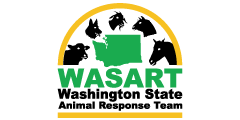
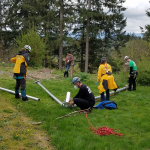
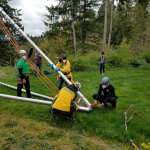
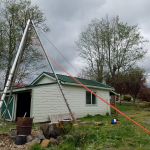
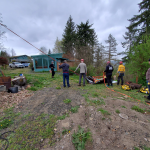
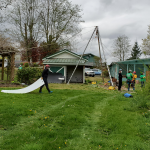

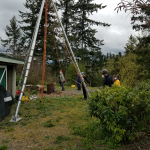
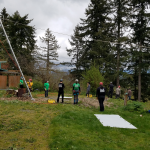
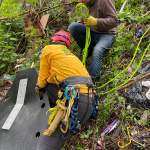
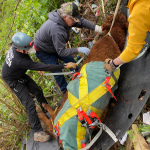
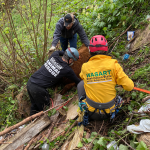
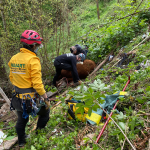
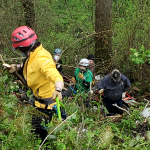
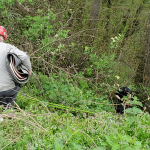
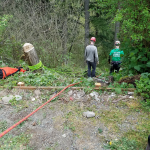
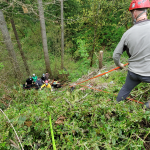
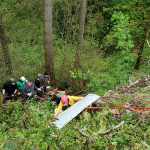
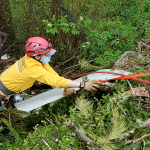
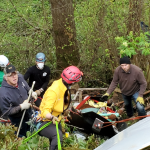
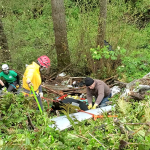
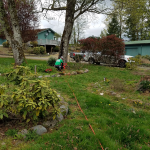

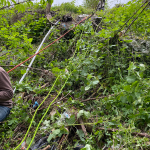
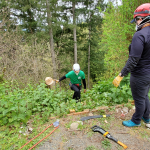
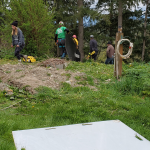
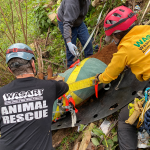
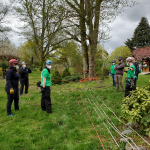

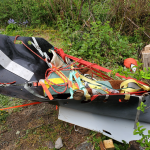
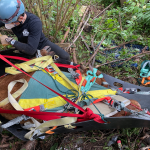

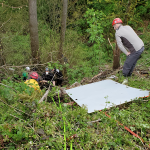
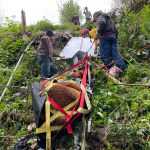
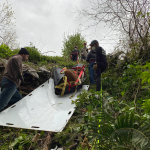

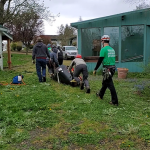
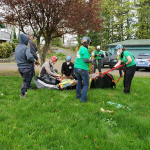
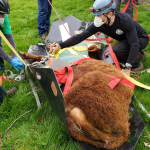
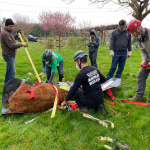
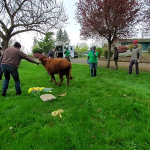
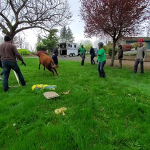
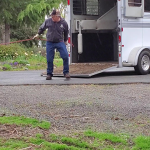
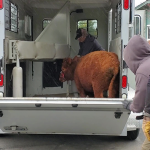
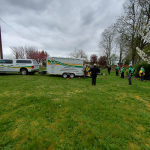
 Buster, Horse Down a Slope
Buster, Horse Down a Slope